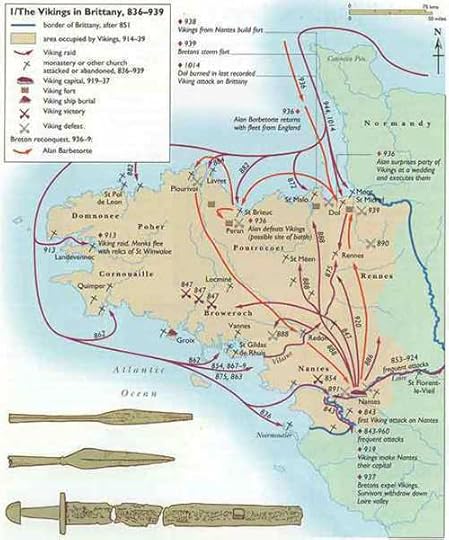Vikings in Brittany: Part III
Muddied and trite, the Bretons began a long period of restoration to repair damage done by the Vikings. Still, the overlords from the north seemed a new permanent feature to the Breton landscape. Raids intensified in the continuing decades after the apt Alain the Great — who expelled the Vikings under Solomon — died without a suitable or qualified heir. The situation grew more difficult when a Viking force comprised primarily of Danes sacked and occupied Nantes a second time. Defeated, the Bretons retreated to their countryside where they squabbled in civil war over who should lead them to victory against the invaders.
Then, a glimmer of hope appeared in 913 C.E. with the birth of a child. His legend says that saints attended his birth and he received many blessings. In actuality, his birth would have been as unremarkable as any other, only this child was the grandson of Alain the Great. Through a strangely contrived marriage, the child received an invitation from his godfather King Athelstan of Wessex to live under the protection of his kingdom. No manuscripts have survived which tell us of the child’s upbringing in England, but he emerged a giant among men. His name was Alain Barbe-Torte. He earned his name from the uneven cut of his beard, which was a trait he shared with his grandfather according to one chronicle.
Alain held all the virtues of an effective leader: charismatic, cunning, quick-whited, and of course full of the utmost prowess in combat. Upon his return he laid claim to the throne of Brittany. The little resistance he encountered was squashed. It took little more than a fortnight for Alain to gain support from the entire kingdom. Thus began one of the more aggressive and seldom known military campaigns of the Viking Age. Alain led an army beginning in Normandy where many Vikings entered into Brittany having been forced out of the Seine river valley by Charles the Bald. It is difficult to imagine that Vikings could be the victims of a massacre, but at the hands of Alain Barbe-Torte they certainly were.
After cleansing the northern territories of Brittany of the Vikings, Alain marched south: straight for Nantes. As they passed through Viking held villages Alain’s troops left a wake of devastation behind them. Further and further they marched into the Loire river territory, and the more nervous the usurpers of Nantes became. The final push besieged Nantes where, conveniently enough, a fresh fleet of Vikings had sailed up the river to sack the city. Alain recruited these Vikings to help him sack the city. His agreement with them included something unusual: a settlement charter. The agreement was that if these Northmen joined him in battle, Alain would grant them rights to fertile lands in the Loire River Valley; so long, of course, they also convert to Christianity. With a deal brokered, the two armies converged on a heavily fortified Nantes. Within two days the city was taken.
The end of the Viking Age was upon Brittany. After over a century of turmoil and strife, the invasions and raids subsided. This was due to a global slowing of the Scandinavian exodus that changed the world, as well as the harsh tactics utilized by Alain Barbe-Torte. Alain established a strict legal code in Brittany, as well as permanent coastal defenses, secured trade routes, and a navy capable of intercepting approaching fleets. The Bretons had reclaimed their independence. Breton Sovereignty lasted until the 15th Century when the dukes of Brittany finally accepted to join the kingdom of France.






